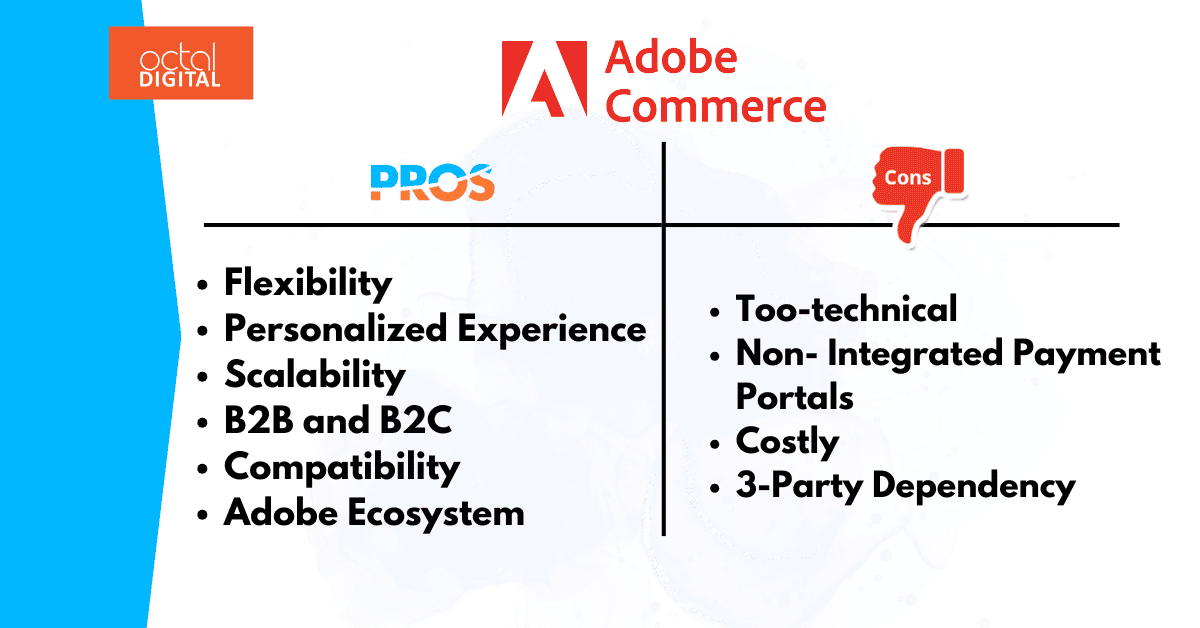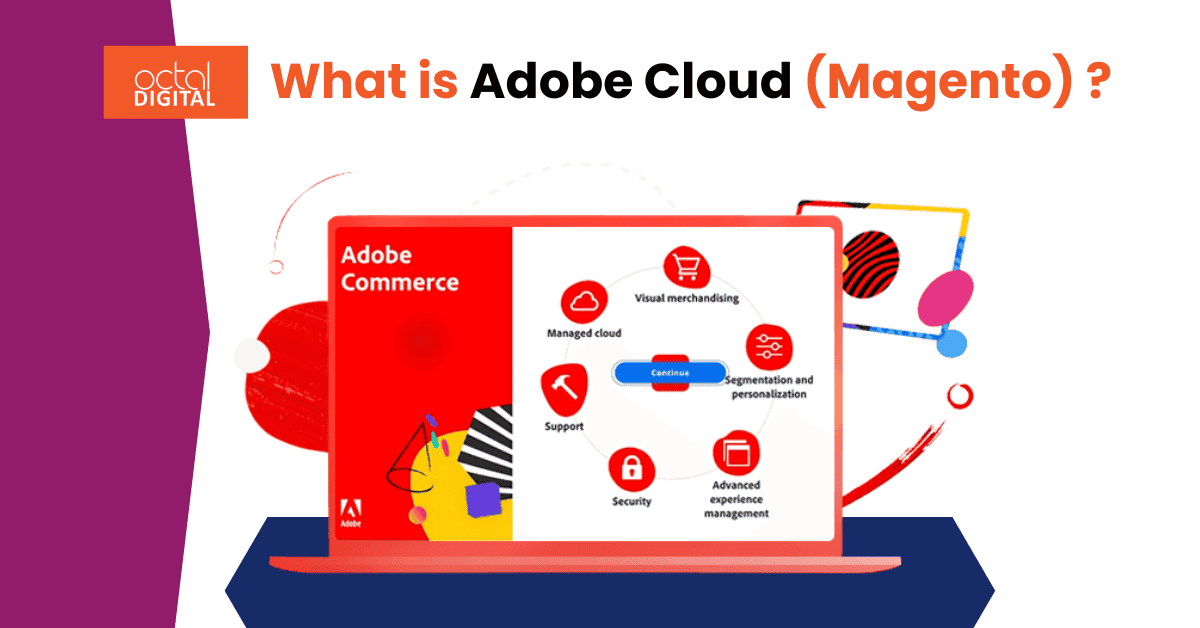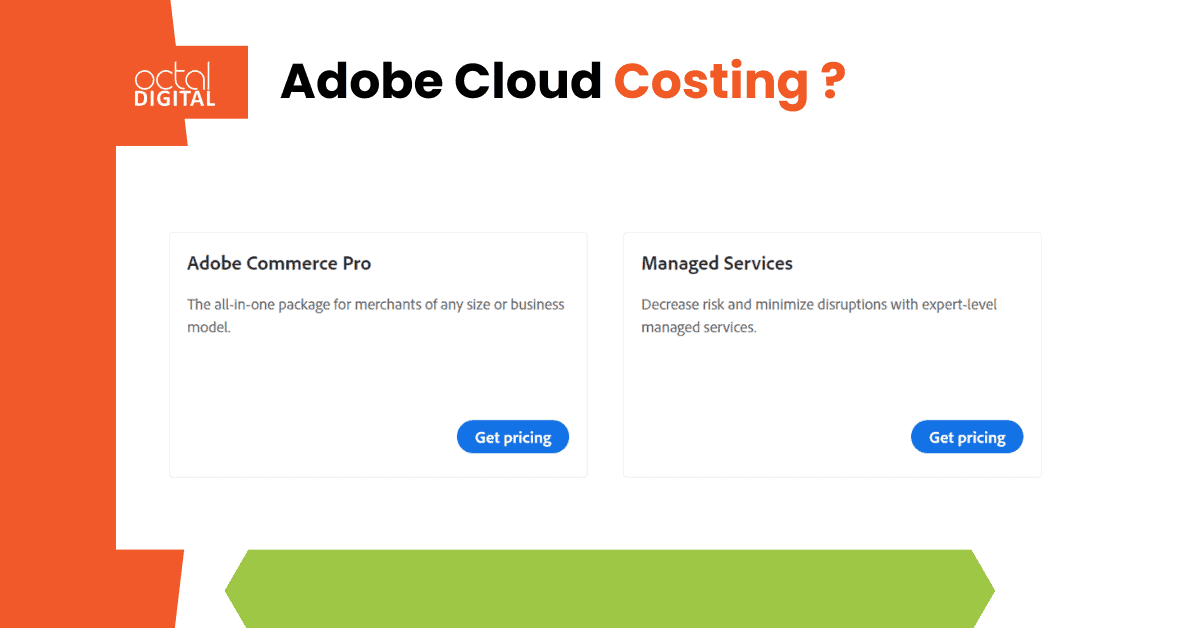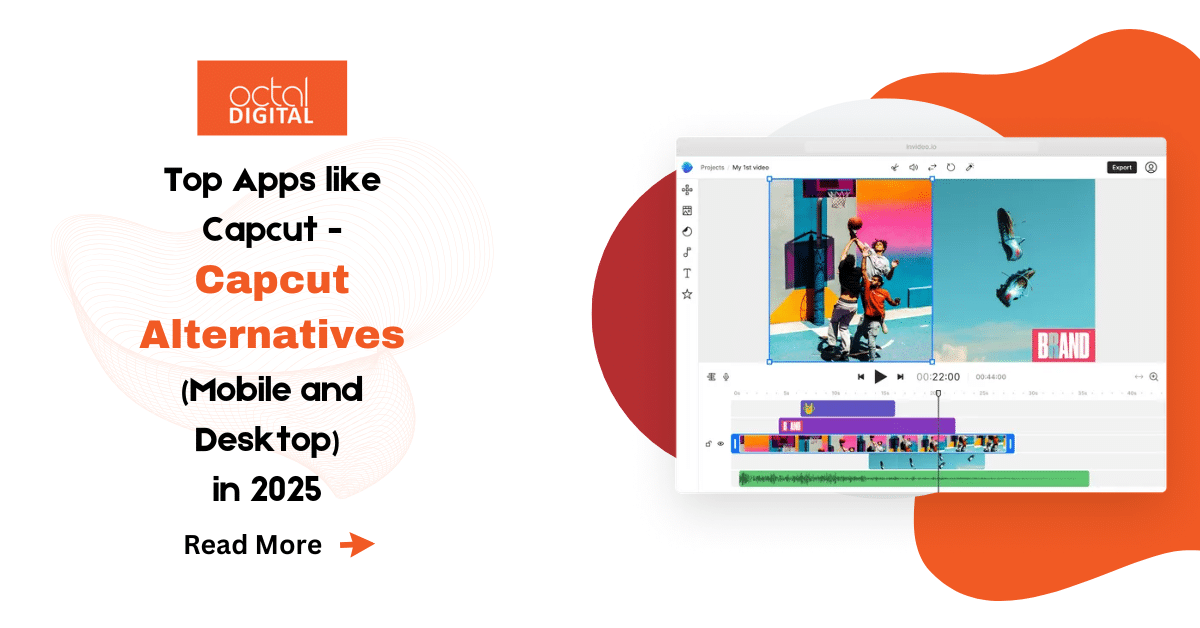Adobe Commerce, formerly known as Magento, is now a part of the Adobe Experience Cloud, acquired for $1.68 billion in May 2018 by Adobe. Initially, in 2007, Magento was developed as an open-source e-commerce platform written in PHP, whereas the current Adobe Commerce is a licensed e-commerce solution that uses Magento Open Source, available for both on-premises and cloud-based infrastructure deployment.
With this business collaboration, Adobe Commerce (i.e. Magneto) holds great potential for the future of the e-commerce marketplace. Let’s uncover “What is Adobe Commerce” and its features today!
Table of Contents
ToggleWhat is Adobe Commerce?
Adobe Commerce is an enterprise-level headless e-commerce solution, designed to help businesses smoothen customer interactions and their shopping journey and manage the online marketplace from lead generation to sales and customer support. It offers B2B and B2C sites and marketplace solutions, developed on a single integrated platform. Adobe Magento’s cloud-based infrastructure currently powers over 150000 online stores, from retailers, and consumer brands to manufacturers and wholesale distributors globally.
Adobe Sensei: AI-Powered Adobe Commerce (Magento)

With the recent AI-powered Adobe Commerce recommendation engine update, businesses can personalize user experiences to increase conversions 10 times and average order values 9 times. Adobe Sensei AI include:
- Intelligent Category Merchandising: Optimize the order products that appear on category pages to increase relevance for each shopper and boost conversion rates.
- Intelligent re-ranking: Adobe Sensei uses AI and ML ranking algorithms to optimize the product order in search results for each customer. This ensures that the user gets the right product suggestion, at the right time boosting business sales.
- Product Recommendations: Offer instant custom product recommendations based on shopper behavior, popularity, and more.
- Segment-specific content and promotions: Brands will be able to create rules-based customer segments that trigger targeted content and promotions. It will help in the automation of customer-facing tasks.
Recommended Read: Benefits of Magento Cloud Hosting 2024
Reasons to Choose Adobe Commerce as an E-commerce Platform
1. Quick Checkout
Adobe Commerce eases the checkout process with minimal steps, offering features like guest checkout, address auto-complete, and saved payment methods to reduce cart abandonment and enhance user experience.
2. Multi-brand Solution
Manage multiple brands, stores, and catalogs from Adobe Commerce’s single backend, enabling seamless operations for businesses with diverse portfolios while maintaining unique brand identities for each storefront.
3. Mobile Centricity
Fully responsive and mobile-optimized design, delivering a smooth shopping experience on all devices. Features include touch-friendly navigation, fast loading times, and mobile-specific enhancements.
4. Integrated B2B and B2C Functionality
Easily manage business-to-business and business-to-consumer operations, including company accounts, custom pricing, bulk ordering, request-for-quote processes, and easy reordering options tailored to wholesale customers.
5. Headless Commerce
With Adobe Commerce’s headless architecture functionality, deliver content and commerce experiences across various platforms (web, mobile, IoT, and more) flexibly using APIs while decoupling the front end from the backend for a seamless omnichannel strategy.
6. Amazon Sales Channel
Integration with Amazon, allowing businesses to manage listings, pricing, and inventory directly from the Adobe Commerce dashboard, helping to synchronize their eCommerce store with Amazon operations.
7. Channel Manager
Centralized platform for managing multiple sales channels, providing visibility and control over orders, inventory, and customer data across marketplaces and social commerce platforms.
8. Payment Services
Built-in payment processing with support for multiple payment methods, fraud prevention tools, and PCI compliance to ensure secure transactions and improve checkout experiences.
9. Powerful User Experience
Advanced personalization, AI-driven recommendations, and seamless navigation ensure customers enjoy a compelling and engaging shopping journey.
10. Page Builder
Adobe Commerce allows a drag-and-drop interface for creating dynamic and visually appealing web pages without coding, allowing for quick updates and customizations to storefront designs.
11. Product Recommendations
AI-powered product suggestions based on customer behavior, purchase history, and trends to increase cross-sells, upsells, and overall cart value.
12. Catalog Service
Robust catalog management features, including bulk product import/export, inventory tracking, and support for complex pricing rules and product configurations.
13. Live Search
The AI-powered search functionality of the Adobe Commerce platform delivers fast and accurate search results with features like autocomplete, filters, and personalized suggestions to improve user experience and boost conversions.
14. Inventory and Order Management
Comprehensive tools for tracking inventory across multiple warehouses, synchronizing stock levels in real-time, and streamlining order fulfillment to ensure timely delivery.
15. Store Fulfillment
Allow Support for buy-online-pickup-in-store (BOPIS), curbside pickup, and ship-from-store options to enhance customer convenience and streamline fulfillment operations.
16. PWA Studio
Get robust tools for developing Progressive Web Apps (PWAs) with Adobe Commerce, to deliver app-like experiences on mobile devices, with features like offline support, fast loading, and push notifications.
17. Customer Account Management
Adobe Commerce’s self-service portal for customers to manage their accounts, view order history, track shipments, and save payment methods for future purchases.
18. Business Intelligence
AI-powered advanced data analytics tools allow businesses to track performance metrics, customer behavior, and sales trends, empowering businesses with actionable insights to drive growth.
19. Reporting and Visualizations
Pre-built and customizable reports with visual dashboards to analyze sales, customer segmentation, and other KPIs, enabling data-driven decision-making.
20. Cloud Delivery
Get fully managed cloud hosting with automatic updates, high availability, and scalability, ensuring a reliable and fast eCommerce platform.
21. Data Warehousing and Management
Centralized platform for storing and managing large volumes of data, ensuring seamless access and integration across business systems.
22. Optimized Performance
High-performance architecture with caching, CDN support, and elastic scalability to handle traffic spikes and ensure fast loading times for a seamless user experience.
23. Security
It features robust security measures like two-factor authentication, data encryption, and regular security patches to protect against potential threats and vulnerabilities.
24. Extensibility
With the open-source platform, developers get support for third-party integrations and custom modules to enhance functionality and adapt the platform to specific business needs.
25. PCI Compliance
The security architecture is in compliance with PCI DSS standards for the secure handling of sensitive user data such as payment data, reducing risks associated with payment processing.
26. ERP Integration
Businesses can now integrate with Enterprise Resource Planning (ERP) systems to trigger business operations like inventory management, order processing, and financial accounting.
Why do We Need Adobe Commerce?
Adobe Commerce offers robust e-commerce solutions to help in launching brand-customized marketplace experiences, that are easy and quick to deploy without developing from scratch. It includes:
- First Mover’s Benefit: Due to increasing competition and demands in the B2B and B2C marketplace, it is necessary for businesses to make the first move. Adobe Commerce offers an adaptable headless solution that launches features faster, streamlines data exchange across composable services, and reduces maintenance costs. Get to market fast with a secure, high-performance foundation of commerce functionality.
- API-First Architecture: With Adobe Commerce’s (Magento) API-based headless commerce platform, you get seamless, connected customer experiences across every channel and device that is agile, fast, and flexible. The API first approach helps you to control every customer interaction, anywhere, at any time using a comprehensive GraphQL API.
- Open-Source Platform: It can integrate with third-party services to build composable shopping experiences using Adobe Developer App Builder. These apps extend native functionality and easily integrate with third-party solutions in a serverless PCI-compliant environment. Developers can build real-time integrations with back-office systems like order management and ERPs using commerce API and events.
- Cost-effective: Customizing and integrating online stores with App Builder tools effectively lowers the cost of ownership. Not to mention, you get overall support for various e-commerce functionalities on the same platform.
Why do Merchants Use Adobe Commerce
There are many popular opinions on why merchants prefer to use Adobe Commerce. Here are a few of them:
Customization: Adobe Commerce offers advanced customization and flexibility to meet the needs of B2C and B2B stores.
Personalization: Adobe Commerce’s AI-powered tools allow merchants to personalize the shopping and purchasing experience for customers.
Scalability: Adobe Commerce is designed to scale with a business, regardless of the industry, and can handle high traffic levels and large product catalogs.
Features: As mentioned in our earlier section on “why to choose Adobe Commerce”, it has many out-of-the-box features, such as inventory and order management, integrated checkout, payment, and shipping solutions, CMS page builders, product recommendations, analytics, and a lot more.
Content staging: It offers a separate content environment within an application that comes in really handy to allow pre-testing for bugs, and create or modify webpages before publishing them to the live website.
Cloud Infrastructure: Adobe Commerce Cloud includes the following:
- Triple redundancy across different AZs (either Azure or AWS)
- True split architecture for application and DB
- Auto-scaling for peak season and events
- Individual Production and Staging environments, plus multiple Integration environments that you can spin up and down within a few minutes.
- Included extras: Fastly CDN/WAF/DDos & New Relic
If you want to get a robust Magento Commerce development, connect with the top Magento eCommerce development company in the USA, Octal Digital. We will help you in developing an amazing e-commerce Store and launching that. The ongoing maintenance makes our company the most reliable team of top US-based Magento developers.
Which Companies Use Adobe Commerce
Many big brands have recently migrated 100% to Adobe Commerce (formerly Magento) due to its flexibility and scalability scopes. The powerful Adobe Commerce editor makes it ideal for large enterprises with the resources and budget to work on the site. For example, Canon and Coca-Cola use Adobe Commerce for their business websites because of the flexibility and scalability granted by the platform.
Other prominent companies/brands functioning on Adobe Commerce include:
- HP
- LIEBHERR
- Shoebacca
- Rossignol
- Helly Hansen
- SCUF Gaming
- SalonCentric
- Lovesac
- Marc Fisher
- Lafayette148
- Killer Ink
- Alshaya Group
- Shinola
- Wyze Labs
Adobe Commerce: Costing
Although the pricing of Adobe Commerce is not shared directly on their official website, a store’s total cost quote may vary due to many factors, such as:
- Adobe/Magento edition,
- Hosting,
- Web store customization,
- Extensions
- Add-ons,
- Payment service fees,
- Digital marketing efforts,
- Post-deployment maintenance
For a mid-to-large scale company, it may cost anywhere around $5,000 for a basic online store based on the Magento Open Source edition, while a more complex Adobe Commerce Cloud store can easily cost you at least $50,000.
Adobe Commerce (Magento): Pros and Cons

Pros:
- Flexibility: Since the platform is open source, there are no limits for developers to play around designing and adding complex business solutions. Thanks to the flexibility of Adobe Commerce’s editor, developers are not confined to pre-defined states and can leverage creativity to its full potential. This flexibility makes your business stand out compared to other drag-and-drop template-fixed platforms.
- Personalized Experience: With Adobe Commerce, businesses can implement AI-powered tools and generate customized experiences for users, such as timely promotional offers or user-specific product recommendations.
- Scalability: Large-scale merchants can be worry-free when it comes to future scalability. With Adobe Commerce, there is no need to worry about outgrowing the website’s capability to handle sudden traffic spikes, since it offers well-optimized and reliable site performance and monitoring tools.
- B2B and B2C Compatibility: This feature stands at the forefront when compared with its other competitors such as Shopify, Wix, etc. Businesses can easily manage both Buisness-to-Buinsess and Buinsess-to-Consumers operations.
- Adobe Ecosystem: You can connect your website with popular Adobe integrations, such as Adobe Analytics and Adobe Experience Manager
Cons
- Too-technical: To design Adobe Commerce (magneto) stores, developers’ coding knowledge and skills are required. Not to mention, even for day to day store updates will require someone who is somewhat tech-savvy. Thus, it’s a con as it’s less accessible and user-friendly than other competitor website builders.
- Non-integrated Payment Portals: Businesses need to install apps to use popular payment processors, such as Stripe or Square individually and subscribe to their working model. Thus, it gets hectic to manage multiple payment Portals.
- Costly: Most of the templates come with a price tag, ranging from $25 to $500. In fact, the overall initial cost of development is also too high as mentioned earlier. Thus, it fits best for big companies, looking for a one-stop commerce platform.
- 3-Party Dependency: Adobe Commerce often requires third-party app integration (i.e. being an open-source platform) for added functionality, such as email marketing – and most of these apps cost extra.
Conclusion
This merger and shift of powerful e-commerce Magento to Adobe Commerce has brought many business opportunities for online marketplace players, combining the best of Magento with Adobe’s features. It offers many features, customization options, and easy integration along with the latest AI (Abode Sensei) engine, with other Adobe products.
Ultimately, businesses can now provide outstanding digital experiences to their customers, that too at a single platform with Adobe Commerce’s headless architecture. To learn more about Adobe Commerce and discuss how it can help you unlock your online store, get a quote from our top Magento developer experts today!
FAQ
1. What is Adobe Commerce used for?
Adobe Commerce is an e-commerce platform built on open-source technology (formerly known as Magento), which provides businesses and brands with a cloud-based infrastructure marketplace, including content management, sales, and catalog management, user suggestions, and various other functionalities to run successful online stores. Magento offers powerful marketing, search engine optimization, and catalog management tools.
2. Is Adobe Commerce (Magento) a CRM?
Yes, Adobe Commerce (also called Magento) is a headless CRM software. It’s specifically designed to help Magento-based businesses manage and analyze customer interactions and visualize data across their shopping journey, from lead generation to sales and customer support.
3. What is Adobe Commerce (Magento) Costing?
For a mid-to-large scale company, it may cost anywhere around $5,000 for a basic online store based on the Magento Open Source edition. While a more complex Adobe Commerce Cloud store can easily cost you at least $50,000.
4. Which companies does Adobe Commerce (Magento) suits the best?
Ideally, large-scale companies with ample resources make the best use of Adobe Commerce’s platform, as it requires 3-party app integrations.
5. Is Adobe Commerce SaaS or PaaS?
Adobe Commerce offers a highly performant Software-as-a-Service (SaaS). It’s highly capable of supporting merchandising and catalog management, including AI Product Recommendations, and Catalog Service.








